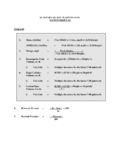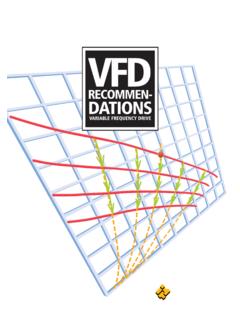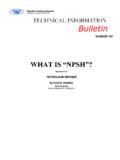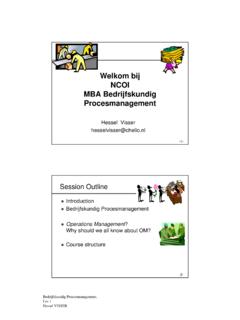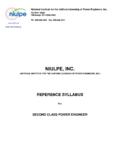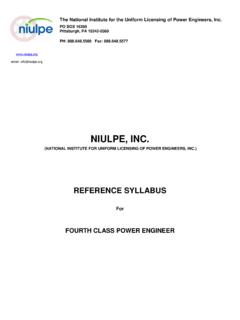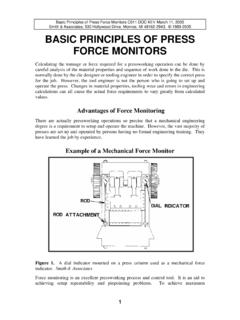Transcription of TECHNICAL INFORMATION Bulletin - gsengr.com
1 Peerless Pump Company Indianapolis IN, 46207-7026 TECHNICAL INFORMATION Bulletin NUMBER SIXTEEN mechanical CONSIDERATIONS IN PUMP design RADIAL LOADS have to be accurately known and their effects thoroughly understood for good mechanical design mechanical failures and excessive maintenance are in most cases a direct result of poor mechanical design , and this is due in a large degree to incomplete knowledge of the radial thrust forces acting on the impeller under actual operating conditions. It was a principle in the past to determine shaft size only on the basis of horsepower transmitted. This has proven incorrect under the light of present experience.
2 Radial loads generally impose greater demands than horsepower does, and should, therefore, be the pre-dominant factor when determining shaft, bearing and stuffing box sizes and configuration. Even when the impeller and other rotating parts are carefully balanced, there is always a variation of pres-sure around the impeller in actual operation. This un-equal pressure is caused by reaction forces which develop as a result of volute configuration and the momentum of the fluid leaving the periphery of the impeller. The resultant of these forces pushes the impeller and its shaft away from their normal axis of rotation.
3 The orientation and value of this resultant is different for different pumps, and even for the same pump under changing conditions of head and capacity. It has taken countless hours of research and experiments to become completely familiar with these forces, which we now simply call radial loads. Their exact measurement, and the development of this knowledge in general, has contributed greatly towards the elimination of shaft failures and other related problems, such as bearing failures, wear ring seizing, stuffing box leakage, etc. It has reduced very substantially the maintenance and repair bills for pumping equipment in every industry.
4 Comparative tests of different types and makes of centrifugal pumps have shown that the evaluation of radial loads is a tricky subject, amounting almost to a character evaluation for a specific unit under specific conditions. It cannot be generalized to cover every product or even a given series of pumps. It cannot be determined with reliable accuracy by any equation or theoretical formula. It has to be measured physically in the laboratory under simulated working conditions, with methods that cannot be applied in the field. Peerless Pump has evolved useful design criteria as a direct consequence of countless measurements and radial load studies through the past years.
5 We present here some of the results of this experience because they are definitely an important consideration when purchasing or specifying pumping equipment for the chemical, petroleum and other processing industries. In these applications, requirements of temperature, pressures, nature of fluids pumped and operating conditions in general, impose far greater demands on equipment than does conventional water service. Through this knowledge, we can now offer better pumps, with the assurance that maintenance problems will be held to a minimum. In addition, however, an awareness of radial loads is also important for the user in the selection of equipment and in the prevention of mechanical failures.
6 Poor hydraulic performance can be detected immediately, but faulty mechanical operation is usually first discovered when a pump ails completely or when irreparable damage has already occurred. RADIAL LOADS have become the center of mechanical design considerations for volute centrifugal pumps, primarily as a result of experiences obtained in the chemical and petroleum processing industries. The general criteria developed, and the overall awareness of the existence and effects of these loads, have greatly contributed to the elimination of a whole series of maintenance problems and failures that could not be explained by other normal reasons.
7 The introduction of radial load factors in our design and engineering, besides resulting in a better product, represents also a definite guarantee of longer, uninterrupted, trouble-free operation. Radial loads are schematically shown by small arrows. The result-ant force is represented by the large arrow. RADIAL LOADS can only be determined by actual measurements and every Pump model should be tested individually The determination of radial loads begins with the physical measurement of shaft deflection. We actually measure the effect rather than the cause. However, after the effect (shaft deflection) has been determined, the radial load to cause this deflection can be easily calculated.
8 To measure radial loads we connect the particular pump to a pressure system in our testing laboratory. Water is used for the test, but we can later make the corresponding correction for values obtained, considering the nature and specific gravity of the fluid for which the pump will be used. Two holes are drilled at the suction end of the casing and we place in these holes threaded sleeves through which the tips of special mechanical probes can reach the end of the shaft. Each probe is directly attached to a micrometer, which provides a direct reading of shaft deflection. To determine the magnitude and direction of the resultant force, we apply the two probes at 90 from each other.
9 Measurements are taken at various head capacity points to obtain a deflection curve through the entire pumping range of the unit. The shaft on the pump tested is then calibrated statically by hanging weights at the impeller location. A load versus deflection curve is obtained, from which the deflection found under running conditions can be converted to the corresponding force. After making a number of measurements throughout the capacity curve, we plot the radial load characteristics of that particular pump, obtaining representative curves similar to the ones shown on page 5. The results normally become duplicative for a production series of pumps of the same type and size.
10 It is possible to relate the radial load F to a series of measurements and physical dimensions of the pump tested. The formula is a purely empirical K = SBHDF22) ( formula widely accepted by industry. K represents the radial load constant. Its numerical value is very useful because it represents the starting point when building a pump similar in design to one already tested. From the above relationships, it is possible to find the constant K for different capacities in the pump being tested. K normally remains a constant only for a given head and capacity condition. By knowing the constant K across the head and capacity ranges for a given line of pumps, it is possible to use a variation of the above equation to predict the radial loads for a new pump of similar design : F = Once a prototype of a new pump is available, we measure the actual shaft deflection, and find the actual radial forces involved.

